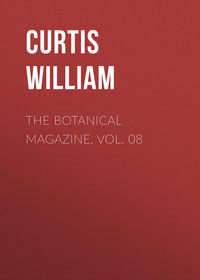 полная версия
полная версияThe Botanical Magazine, Vol. 07

William Curtis
The Botanical Magazine Vol. 07 / Or, Flower-Garden Displayed
[217]
Buchnera Viscosa. Clammy Buchnera
Class and OrderDidynamia AngiospermiaGeneric CharacterCal. obsolete 5-dentatus. Corollæ limbus 5-fidus, æqualis: lobis cordatis. Caps. 2-locularis.
Specific Character and SynonymsBUCHNERA viscosa foliis lineari-lanceolatis laxe dentatis subglutinosis, floribus pedunculatis, caule fruticoso. L' Herit. Strip. nov. tom. 2. tab. 34. Ait. Kew. V. 2. p. 357.
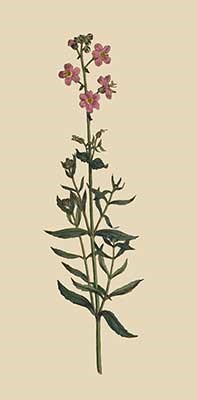
No217.
Buchnera is a genus of plants established by Linnæus in honour of A. E. Buchner, a German naturalist.
Of this genus, nine species are enumerated in the 14th edition of the Systema Vegetabilium, by Professor Murray.
We learn from Mr. Aiton, that the present species (a native of the Cape) was introduced to the royal garden at Kew in 1774.
It cannot boast much beauty, yet as it occupies but little room, grows readily from cuttings, and flowers during most of the summer: it obtains a place in most greenhouses.
[218]
Disandra Prostrata. Trailing Disandra
Class and OrderHeptandria MonogyniaGeneric CharacterCal. sub 7-partitus. Cor. rotata, subseptem-partita. Caps. 2-locularis, polysperma.
Specific Character and SynonymsDISANDRA prostrata. Linn. Syst. Vegetab. ed. 14. Murr. Suppl. Pl. p. 32. 214. Ait. Kew, V. 1. p. 493.
SIBTHORPIA peregrina. Linn. Sp. Pl. ed. 3. p. 880.
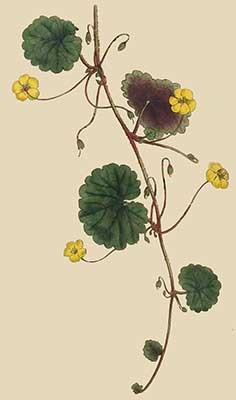
No218.
The foliage of this plant greatly resembles that of Ground Ivy, and its branches trail on the ground somewhat in the same manner, extending to the length of several feet; but it is not on the ground that it is best seen, as its flowers are apt to be hid among the leaves: it appears most advantageously when growing in a pot, placed on a pedestal, or in some elevated situation, where its branches may hang carelessly down: thus treated, when fully blown, it becomes a most pleasing object.
Linnæus, the son, in his Suppl. Plant. observes, that the Disandra varies extremely in the number of its stamina, as it does also in the divisions of its calyx, and corolla; in this respect;, indeed, we do not know its equal: fortunately for those systems of Botany, which are formed from the number of certain parts of the fructification, few such inconstants exist.
Professor Murray observes, that seven is the most prevalent number of its stamina, five the most natural.
Linnæus describes it as a native of the East; Mr. Aiton informs us, that it was introduced here about the year 1771, from Madeira.
It flowers during most of the summer months; in the winter it must be kept in the green-house; in the summer it will bear the open air, grows readily from cuttings, should be planted in rich earth, and plentifully watered in dry weather.
[219]
Michauxia Campanuloides. Rough-Leav'd Michauxia
Class and OrderOctandria MonogyniaGeneric CharacterCal. 16-partitus. Cor. rotata, 8-partita. Nectarium 8-valve, staminiferum. Caps. 8-locularis, polysperma. L' Heritier Monogr.
Specific Character and SynonymsMICHAUXIA campanuloides. L' Heritier Monogr.
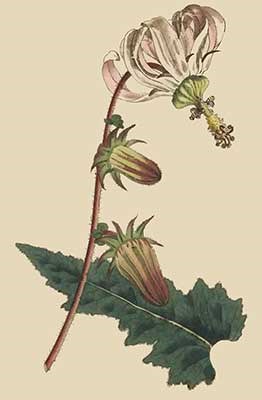
No219.
The celebrated author of the Hortus Kewensis informs us, that the plant here figured is a native of the Levant, and was introduced to this country in the year 1787, by Mons. L'Heritier, who first gave it the name of Michauxia, and wrote a Monographia, or particular treatise on it.
We have before observed, that when a plant has been named in honour of any particular person, that name must be retained in all countries, however uncouth its pronunciation may be, and there are few of our readers but what will think the present name sufficiently so.
Last summer 1792, in the month of July, we had the pleasure to see a fine plant of this sort, fully blown, in the collection of Messrs. Grimwood and Co. Kensington; though in a small pot, it grew nearly to the height of six feet, was branched almost to the bottom, and loaded with a profusion of blossoms, such as are represented on the plate, and which bore some distant resemblance to those of a passion-flower.
It is a biennial green-house plant, and, of course, only to be raised from seeds, which we are sorry to find have not ripened in this country, though they are said to do so in France.
[220]
Erica Cerinthoides. Honeywort-Flower'd Heath
Class and OrderOctandria MonogyniaGeneric CharacterCal. 4-phyllus. Cor. 4-fida. Filamenta receptaculo inferta. Antheræ bifidæ. Caps. 4-locularis.
Specific Character and SynonymsERICA cerinthoides antheris muticis inclusis, corollis clavatis grossis, stigmate incluso cruciato, foliis quaternis. Linn. Syst. Vegetab. ed. 14. Murr. p. 368. Ait. Kew. V. 2. p. 22.
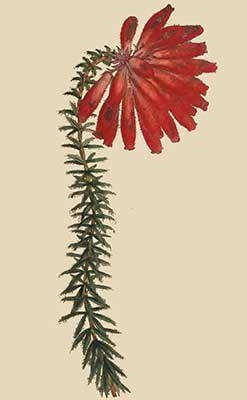
No220.
The Erica cerinthoides is one of the most magnificent and shewy of the genus, grows wild at the Cape, from whence it was introduced to the royal garden at Kew, by Mr. Masson, in 1774; it is the more valuable, as it flowers during most of the year: its blossoms are found to vary from a deep to a very pale red. It is a hardy green-house plant, and usually propagated by cuttings.
To have this beautiful tribe of plants in perfection, they must be kept in pots proportioned to their size, filled with that kind of bog earth in which our British heaths grow spontaneously, finely sifted; to which it may be necessary sometimes to add a third part of the mould of rotten leaves, or choice loam, partaking more of a clayey than a sandy nature: we must be careful not to let them suffer for want of water in dry hot weather, as such an omission, even for one day, may be fatal; and to give them as much air as possible at all times when the weather is mild.
[221]
Ipomœa Coccinea. Scarlet Ipomœa
Class and OrderPentandria MonogyniaGeneric CharacterCor. infundibuliformis, Stigma capitato-globosum, Caps. 3-locularis.
Specific Character and SynonymsIPOMŒA coccinea foliis cordatis acuminatis basi angulatis, pedunculis multifloris. Linn. Syst. Vegetab. ed. 14. Murr. p. 204. Ait. Kew. V. 1. p. 215.
CONVOLVULUS coccineus, folio anguloso, Plum. Amer. 89. t. 103.
QUAMOLCIT americana, folio hederæ, flore coccineo. Comm. rar. 21. t. 21.
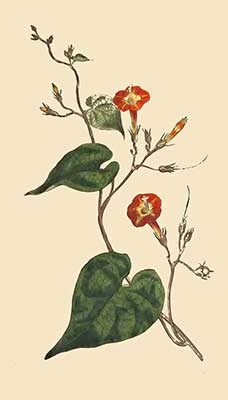
No221.
The Ipomœa is very nearly related to the Convolvulus, one principal difference consists in the different form of its stigma, which is globular, like that of the Primrose; whereas in the Convolvulus it is divided into two substances, as is obviously shewn in the Convolvulus arvensis and sepium, but all the plants of these two genera have not this character marked with equal strength.
The present species is a twining plant, will run up a stick to the height of six, eight, or ten feet, and produce an abundance of flowers, of a rich orange colour tending to scarlet, which renders it one of the most ornamental annuals cultivated in our gardens, into which it is not as yet generally introduced, though cultivated by Mr. Miller, in 1759.
Mr. Miller describes it as a native of Carolina, and the Bahama Islands, Mr. Aiton of the West-Indies; it flowers from June to September.
It is cultivated in the same manner, and with the same ease as other annuals; three seeds may be set in the ground, about four inches asunder, in the form of a triangle; when the seedlings are sufficiently advanced, a tall stick is to be thrust down in the centre betwixt the three plants, for them to twine around: the warmer and more sheltered the situation, and the richer the soil in which they are placed, the taller the plants will grow; by raising them on a hot bed, you may anticipate their natural time of flowering, and be more certain of obtaining good seed.
[222]
Struthiola Erecta. Smooth Struthiola
Class and OrderTetrandria MonogyniaGeneric CharacterCor. nulla. Cal. tubulosus, ore glandulis 8. Bacca exsucca, polysperma. Linn. Mant. p. 4. Syst. Vegetab. ed. 14. Murr. p. 165.
Specific Character and SynonymsSTRUTHIOLA erecta glabra. Linn. Syst. Vegetab. ed. 14. Murr. p. 164. Ait. Kew. V. 1. p. 165.
PASSERINA dodecandra. Linn. Sp. Pl. ed. 3. p. 513. Amæn. Acad. V. 4. p. 271.
PASSERINA filiformis. Mill. Dict. ed. 6. 4to.
PASSERINA. Burm. Afric. t. 47. f. 1.
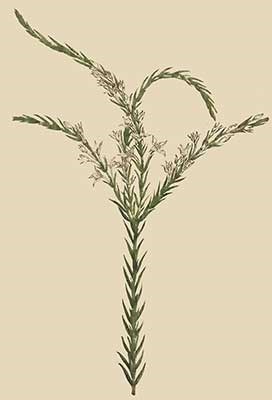
No222.
The plant here represented appears to have been first described and figured by Burman, in his Pl. Afric. under the name of Passerina: Linnæus introduced it in the 3d edition of his Sp. Pl. by the title of Passerina dodecandra; discovering afterwards that it had in reality only four stamina, and that the other eight substances, mistaken for such, were so many glandular nectaria, he made in his Mantiss. Plant. a new genus of it, by the name of Struthiola, and assigned it the trivial name of erecta; in the abbreviated generic description given of it by Prof. Murray, an alteration is made in this generic character, and what before was considered as Corolla, is here regarded as Calyx; no reason is assigned for this alteration, and we are at a loss to account for the propriety of it.
Mr. Miller, who cultivated this plant in 1758, describes it in his dictionary, and observes very justly, that though its branches when young are erect, when loaded with blossoms they incline to a horizontal position; hence the term erecta becomes an improper one, and should be changed for one more expressive.
This species of Struthiola is a very common shrub in our greenhouses, will grow to the height of five or six feet, and, though not so ornamental as some other plants, has the merit of flowering during most of the year, and often in the depth of winter.
Is readily increased by cuttings.
[223]
Lychnis Coronata. Chinese Lychnis
Class and OrderDecandria PentagyniaGeneric CharacterCal. 1-phyllus, oblongus, lævis. Petala 5, unguiculata: Limbo sub-bifido. Caps. 5-locularis.
Specific Character and SynonymsLYCHNIS coronata glabra, floribus axillaribus terminalibusque solitariis, petalis laciniatis. Thunb. Japon. p. 187. Linn. Syst. Vegetab. ed. 14. Murr. p. 435. Ait. Kew. V. 1. p. 117.
LYCHNIS grandiflora floribus axillaribus terminalibusque folitariis, petalis inæqualiter crenatis. Jacq. Collect. V. 1. p. 149. Icon. V. 1.
JAPONICE sen sjun ra, vulgo Ganpi. Kempf. Amæn. Exot. Fasc. V. p. 873.
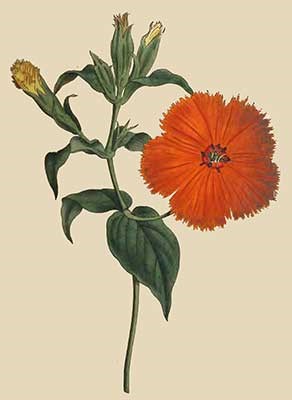
No223.
The rich and elegant blossoms of this Chinese or Japanese beauty, possess a flatness and stiffness, which gives them an artificial air, to which their colour, which is exactly that of common red lead, may perhaps somewhat contribute; they make their appearance towards the close of the summer, and as many (when the plant is in health and vigour) are produced on the same stem, they continue a considerable time in bloom; its root is perennial, and its stem, which rises to the height of about two feet, herbaceous.
We remember to have seen this plant in the collection of the late Dr. Fothergill at Upton, about the year 1774, by whom it was first introduced to this country: Kæmpfer, the celebrated Dutch traveller, who saw it growing in Japan, gives a very short description of it in his Amænitates exoticæ, and mentions a variety of it with white flowers: Professor Thunberg, who saw it also in its wild state, as well as in the gardens of that country, confines himself to describing the plant more at large: Professor Jacquin, in his Icones, has given an admirable figure of it.
Persons here differ in their mode of cultivating this species of Lychnis, some treating it as a stove others as a greenhouse and others as a hardy herbaceous plant; the latter mode is to be preferred, provided care be taken to plant it in a sheltered situation, and to guard it against the inclemency of particular seasons; it is propagated by parting its roots, also by slips, and cuttings, but in this business more than ordinary care is required to be successful.
[224]
Phylica Ericoides. Heath-Leav'd Phylica
Class and OrderPentandria MonogyniaGeneric CharacterPerianthium 5-partitum, turbinatum. Petala 0. Squamæ 5, stamina munientes. Caps. tricocca, infera.
Specific Character and SynonymsPHYLICA ericoides foliis linearibus verticillatis. Linn. Syst. Vegetab. ed. 14. Murr. p. 235. Ait. Kew. V. 1. p. 268.
ALATERNOIDES africana ericæ foliis, floribus albicantibus et muscosis. Comm. Hort. 2. p. 1. t. 1.
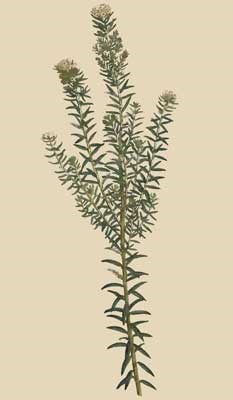
No224.
Mr. Miller, who cultivated this plant in 1731, informs us, that it grows wild about Lisbon, where it covers extensive tracts of ground, in the same manner as the heath does in this country; it seldom rises above the height of three feet, and is much disposed to become bushy; its flowers, which are slightly odoriferous, begin to appear in autumn, and continue during the winter and spring; they grow in little heads on the summits of the branches: their whiteness, contrasted with the dark colour of the foliage, forms a pleasing appearance, and entitles this plant, though a common and long-established inhabitant of the greenhouse, to a place with such as may boast more brilliancy of colour.
Its leaves, which thickly cover the stalks, do not well accord with Linnæus's specific description.
It is usually propagated by cuttings, which strike readily.
[225]
Lobelia Surinamensis. Shrubby Lobelia
Class and OrderSyngenesia MonogamiaGeneric CharacterCal. 5-fidus. Cor. 1-petala, irregularis. Caps. infera, 2 sive 3-locularis.
Specific Character and SynonymsLOBELIA surinamensis caule suffruticoso, foliis oblongis glabris serratis, floribus axillaribus pedunculatis. Ait. Kew. V. 3. p. 498. Sp. Pl. 1320.
LOBELIA lævigata foliis ellipticis serratis glabris, capsulis grossis globosis, calycibus subulatis, corollis glaberrimis. Linn. Suppl. p. 392.

No225.
The Lobelia surinamensis, a plant newly introduced here, is minutely described in the Suppl. Pl. of the younger Linnæus, under the name of lævigata, apparently from the smoothness of its flowers: in the year 1786, Mr. Alexander Anderson sent this plant to the Royal Garden at Kew, from the West-Indies, where it grows spontaneously, as well as at Surinam; and Mr. Aiton has inserted it at the end of the Hort. Kew. assigning to it a new specific description, and a new trivial name: our drawing was made from a plant which flowered in the stove of Messrs. Grimwood and Co. Kensington, to whom it was imparted by Richard Molesworth, Esq. of Peckham, a gentleman liberal in his communications, and anxious to promote the cause of Botany.
This species of Lobelia is a stove plant, having a some-*what shrubby stalk, growing to the height of several feet; its blossoms are very large, of a pale red colour, and its Antheræ, which might be mistaken for the stigma, unusually hairy.
It begins to flower in January and February, and continues to blossom during most of the summer.
Is increased by cuttings.
[226]
Arabis Alpina. Alpine Wall-Cress
Class and OrderTetradynamia SiliquosaGeneric CharacterGlandulæ nectariferæ 4, singulæ intra calycis foliola, squamæ instar reflexæ.
Specific Character and SynonymsARABIS alpina foliis amplexicaulibus dentatis. Linn. Syst. Vegetab. ed. 14. Murr. p. 599. Ait. Kew. Vol. 2. p. 399. Mill. Dict. ed. 6. 4to.
DRABA alba siliquosa repens. Bauh. Pin. p. 109.

No226.
An early-blowing plant, if it has no great pretensions to beauty, brings with it a powerful recommendation, more especially if its flowers are not of the more common hue; such are the claims which the present plant has to a place in this work: it is perennial, hardy, herbaceous, of low growth, rarely exceeding a foot in height, producing its white blossoms in April and May: its size renders it a suitable plant for the border of a small garden, or for the covering of rock-work.
It is readily increased by parting its roots in autumn.
Grows spontaneously on the Alps of Switzerland, Austria, and Lapland, and was cultivated (vid. Hort. Kew) in the Botanic Garden at Oxford, in 1658.
[227]
Helianthus Multiflorus. Many-Flowered or Perennial Sun-Flower
Class and OrderSyngenesia Polygamia FrustraneaGeneric CharacterRecept. paleaceum, planum. Pappus 2-phyllus. Cal. imbricatus, subsquarrosus.
Specific Character and SynonymsHELIANTHUS multiflorus foliis inferioribus cordatis trinervatis superioribus ovatis. Linn. Syst. Vegetab. ed. 14. Murr. p. 781.
CHRYSANTHEMUM americanum majus perenne, floris folis foliis et floribus. Moris. Hist. 3. p. 23.

No227.
The Helianthus multiflorus, a native of North-America, is a hardy perennial herbaceous plant, arising usually to the height of five or six feet, and producing a great number of large yellow shewy blossoms, which renders it a suitable plant to ornament the shrubbery or garden of large extent; the variety with double flowers is the one most commonly cultivated, and this we find in almost every garden: it flowers from July to September, and is propagated by parting its roots in autumn.
This is a hardy plant, of ready growth, will bear the smoke of London better than many others; if it continues in the same spot for a great number of years, the blossoms are apt to become single.
The single sort, according to Morison, was introduced before 1699 by Lord Lemster. Ait. Kew.
[228]
Bellis Perennis var. Major Flore Pleno. Great Double Daisy
Class and OrderSyngenesia Polygamia SuperfluaGeneric CharacterRecept. nudum, conicum. Pappus nullus. Cal. hemisphæricus: squamis æqualibus. Sem. subovata.
Specific Character and SynonymsBELLIS perennis scapo nudo. Linn. Syst. Vegetab. ed. 14. Murr. p. 770.
BELLIS hortensis flore pleno. Bauh. Pin. p. 261.
BELLIS minor hortensis flore pleno. Double Garden Daisy. Park. Parad. p. 322.
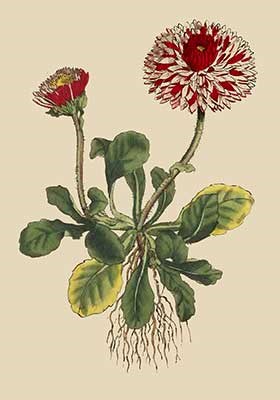
No228.
The daisy, a plant common to Europe, in its wild state delights in open situations, which are moderately moist, its root is perennial, and increases greatly; the usual colour of its flowers is white, the florets are sometimes tipt with red, but more frequently red on the under side.
When double, the daisy becomes much more ornamental, and in this state many varieties of it have long been cultivated, very generally in gardens; those principally found in our nurseries are
The large double daisy with florets of a deep red colour on the under side, figured on the plate; the flowers of this sort will sometimes expand nearly to the size of a half-crown piece, and are the most shewy of any that we have seen; the foliage of this sort is also proportionably larger.
The pale red double daisy, more delicate in its appearance, but smaller, varying in its shades of colour.
The pure white double daisy.
The deep red double daisy; in this the petals are usually tubular or quilled.
Besides these, there are
The coxcomb double daisy, both red and white, in which the flowering stem rises up preternaturally flattened, and carries on its summit a long-extended ridge of flowers, frequently of an enormous size; this monstrous production seems to arise from the coalescence of two or more flowering stems: and as it is of accidental origin, so we find that a daisy which has been a coxcomb one year, shall lose that appearance entirely the next, and out of a long edging of daisies growing luxuriantly, new ones shall here and there arise; we cannot therefore depend upon the constancy of this variety.
Another singular variety is the proliferous or hen and chicken daisy, in which a number of flowers standing on short footstalks spring circularly out of the main flower; as this appearance for the most part arises from great luxuriance1, this sort of daisy is also found occasionally to lose its prolific character: in my garden at Lambeth-Marsh, I once had a daisy growing in an edging among a number of others, which not only became proliferous, or of the hen and chicken kind, but its stalk also, or scapus, became branched, producing six or seven flowering-stems, with flowers at their extremities of the size of the common daisy; thus we find that the most permanent characters of plants are liable to be altered, and even destroyed, by accident, or culture.
Daisies appear to most advantage planted as an edging to a border, not that they are superior, or even equal to box for the great purposes of an edging; but in the spring of the year they enliven the border more, and add much to the general gaiety of the garden: in the formation of these, we shall give our readers some practical instructions, which will enable them to succeed much better than by following the mode commonly practised.
The last week in September, or the first in October, take up your daisy roots, and divide them into single plants; your border being dug, put down your line, and make a shallow trench along it as for the planting of box; in this trench place your plants three inches apart, spreading out their fibres in the trench, and pressing the earth closely round them; in this way they will soon become rooted, and firmly fixed in the ground before the approach of frost; should this business be deferred later, as it frequently is, and the daisies be planted with a dibber in the usual way, in all probability the worms will draw out every plant before spring, especially if the earth has been rendered loose by repeated frosts.
Edgings of this kind require to be replanted in the same way every autumn, as the plants, if they grow well, spread too wide; if the summer prove dry, many of the roots fail, and if they remain undisturbed in the same spot, they will degenerate and become single, notwithstanding Mr. Miller informs us, that he never observed them to do so.
[229]
Primula Acaulis Fl. Pleno Carneo. Double Lilac Primrose
Class and OrderPentandria MonogyniaGeneric CharacterInvolucr. umbellulæ. Corollæ tubus cylindricus ore patulo.
Specific Character and SynonymsPRIMULA acaulis foliis rugosis dentatis, subtus hirsutis; scapis unifloris. Jacq. Misc. Austr. p. 158. Curt. Flor. Lond. Fasc. 6.


